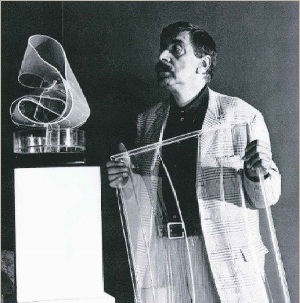
Evaluation Sante Monachesi
Sante Monachesi Valuations - Want to sell a Sante Monachesi piece? Request a complimentary and confidential valuation!Colasanti Casa d'Aste will review your submission and offer a free-of-charge estimate, if your item is suitable for our auctions.
biography
Sante Monachesi was an Italian artist, painter, and sculptor born in Macerata on January 10, 1910. After completing his studies at the Royal School of Apprenticeship in Macerata, he moved to Rome where in 1936 he attended the scenography course at the Centro Sperimentale di Cinematografia. Influenced by Umberto Boccioni's book "Futurist Painting and Sculpture," Monachesi developed in the 1930s an artistic production characterized by spiral and diagonal structures, creating his unique "Extra Futurist Aerodynamic Plastic." In 1932, together with Bruno Tano and other artists, he founded the "Futurist Movement in the Marche," also known as the Umberto Boccioni Futurist Group, marking a key moment in his artistic career.
During the 1930s, he participated in major exhibitions such as the 1936 Paris Universal Exposition, the 1938 Venice Biennale, and the 1939 Rome Quadriennale, with notable presentations including that of F.T. Marinetti. His work was praised by prominent critics and intellectuals including Filippo Tommaso Marinetti, Palma Bucarelli, Giulio Carlo Argan, and Giorgio Bassani.
After his Futurist phase, Monachesi directed his research towards a figurative poetics characterized by broad color planes and synthetic filaments, evident in his works from the 1940s and 1950s, also inspired by his postwar stay in Paris. Among his best-known works from this period are the cycles "Blind Walls," "Paris," "Flowers," and "Clownesses." His production spans painting and sculpture, with particular attention to primary forms and the use of materials such as plaster and raw earth.
Monachesi is considered a significant figure in the Italian 20th-century art scene, with a career that combined Futurism with continuous stylistic evolution.
During the 1930s, he participated in major exhibitions such as the 1936 Paris Universal Exposition, the 1938 Venice Biennale, and the 1939 Rome Quadriennale, with notable presentations including that of F.T. Marinetti. His work was praised by prominent critics and intellectuals including Filippo Tommaso Marinetti, Palma Bucarelli, Giulio Carlo Argan, and Giorgio Bassani.
After his Futurist phase, Monachesi directed his research towards a figurative poetics characterized by broad color planes and synthetic filaments, evident in his works from the 1940s and 1950s, also inspired by his postwar stay in Paris. Among his best-known works from this period are the cycles "Blind Walls," "Paris," "Flowers," and "Clownesses." His production spans painting and sculpture, with particular attention to primary forms and the use of materials such as plaster and raw earth.
Monachesi is considered a significant figure in the Italian 20th-century art scene, with a career that combined Futurism with continuous stylistic evolution.



















